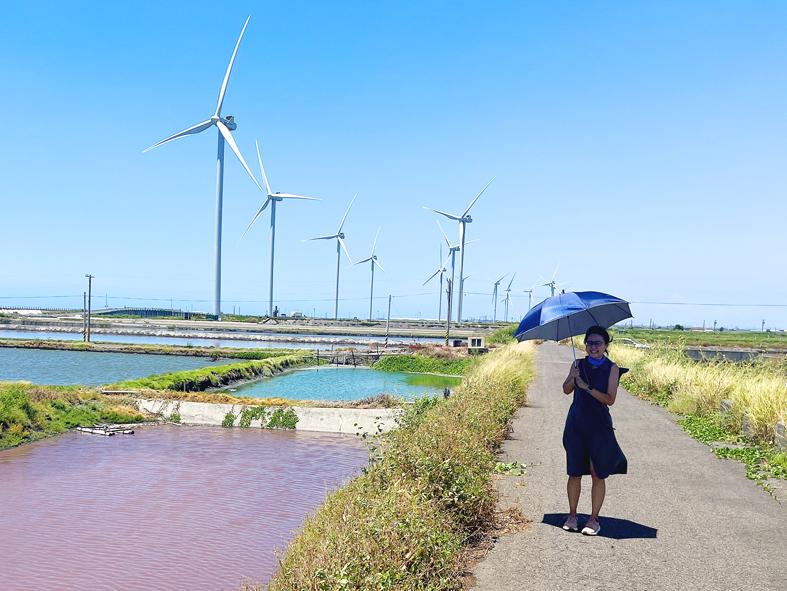The Ministry of Economic Affairs on Friday said it expects the nation to obtain 15.1 percent of its electricity from renewable sources by 2025, falling short of a 20 percent target set by President Tsai Ing-wen (蔡英文) in 2016.
The Taiwan Energy Statistics Year Book report, published on Friday by the Bureau of Energy, said that the share of renewables in the nation’s electricity mix had increased to 6 percent by the end of last year and is expected to reach 8 percent by the end of this year.
After taking office in 2016 — when renewables accounted for 4.1 percent of Taiwan’s electricity mix — Tsai laid out plans to obtain 20 percent of the nation’s electricity from renewables by 2025, with 50 percent coming from natural gas and 30 percent from coal.

Photo: CNA
The plan was part of a campaign promise to phase out the country’s three remaining nuclear power plants, which provided about 9.6 percent of Taiwan’s electricity last year.
The report blamed the target shortfall on increasing demand for electricity.
Electricity consumption last year rose 4.5 percent from a year earlier, driven by increased production in the manufacturing sector after the global economy rebounded from the COVID-19 pandemic, the report said.
Meanwhile, integrating renewable energy sources into the grid in a way that allows them to operate at full capacity remains a challenge, with grid connections for renewable sources not expected to be completed until the end of 2025, it said.
The government is now hoping to realize Tsai’s 20 percent target by October 2026, it added.
By utilizing power generation from offshore wind farms, solar projects and biofuel energy, the government aims to increase the share of renewables to 21 percent in 2027 and 23 percent in 2028, the report said.
As of the end of last year, the nation’s total solar installation only reached 7.7 gigawatt (GW), missing the government’s target of 8.75GW, energy bureau data showed.
It was the third consecutive year Taiwan failed to meet its solar installation goal.
The 2020 target was 6.5GW, but only 5.82GW was operational at the end of that year, the data showed.
To achieve the government’s 2025 target of 20GW from solar installations, it must annually add a capacity of 3GW from this year.
However, the nation’s newly added capacity was 680 megawatt in the first five months of the year, reaching only 22.7 percent of the year’s target, with accumulated installation of 8.38GW far below the government’s expectations.
Companies in the solar industry attributed the slower-than-expected adoption to soaring raw material prices, logistics bottlenecks caused by COVID-19 lockdowns in China, worldwide port congestion and surging freight rates.
The bureau said it had launched several measures to encourage solar installation, including on June 28, announcing it would maintain its solar feed-in tariffs for the second half of the year, citing rising installation costs.
It also started requiring rooftop solar system installation on suitable buildings, regardless of whether they are newly built, extensions or reconstructions, it added.
Additional reporting by Chen Cheng-hui

Nvidia Corp chief executive officer Jensen Huang (黃仁勳) on Monday introduced the company’s latest supercomputer platform, featuring six new chips made by Taiwan Semiconductor Manufacturing Co (TSMC, 台積電), saying that it is now “in full production.” “If Vera Rubin is going to be in time for this year, it must be in production by now, and so, today I can tell you that Vera Rubin is in full production,” Huang said during his keynote speech at CES in Las Vegas. The rollout of six concurrent chips for Vera Rubin — the company’s next-generation artificial intelligence (AI) computing platform — marks a strategic

Enhanced tax credits that have helped reduce the cost of health insurance for the vast majority of US Affordable Care Act enrollees expired on Jan.1, cementing higher health costs for millions of Americans at the start of the new year. Democrats forced a 43-day US government shutdown over the issue. Moderate Republicans called for a solution to save their political aspirations this year. US President Donald Trump floated a way out, only to back off after conservative backlash. In the end, no one’s efforts were enough to save the subsidies before their expiration date. A US House of Representatives vote

REVENUE PERFORMANCE: Cloud and network products, and electronic components saw strong increases, while smart consumer electronics and computing products fell Hon Hai Precision Industry Co (鴻海精密) yesterday posted 26.51 percent quarterly growth in revenue for last quarter to NT$2.6 trillion (US$82.44 billion), the strongest on record for the period and above expectations, but the company forecast a slight revenue dip this quarter due to seasonal factors. On an annual basis, revenue last quarter grew 22.07 percent, the company said. Analysts on average estimated about NT$2.4 trillion increase. Hon Hai, which assembles servers for Nvidia Corp and iPhones for Apple Inc, is expanding its capacity in the US, adding artificial intelligence (AI) server production in Wisconsin and Texas, where it operates established campuses. This

US President Donald Trump on Friday blocked US photonics firm HieFo Corp’s US$3 million acquisition of assets in New Jersey-based aerospace and defense specialist Emcore Corp, citing national security and China-related concerns. In an order released by the White House, Trump said HieFo was “controlled by a citizen of the People’s Republic of China” and that its 2024 acquisition of Emcore’s businesses led the US president to believe that it might “take action that threatens to impair the national security of the United States.” The order did not name the person or detail Trump’s concerns. “The Transaction is hereby prohibited,”